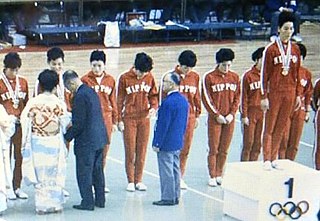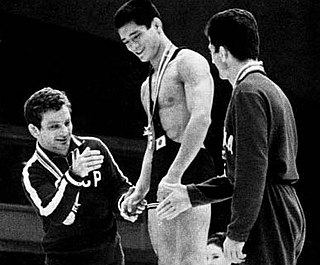
The 1964 Summer Olympics, officially the Games of the XVIII Olympiad and commonly known as Tokyo 1964, were an international multi-sport event held from 10 to 24 October 1964 in Tokyo, Japan. Tokyo had been awarded the organization of the 1940 Summer Olympics, but this honor was subsequently passed to Helsinki due to Japan's invasion of China, before ultimately being cancelled due to World War II. Tokyo was chosen as the host city during the 55th IOC Session in West Germany on 26 May 1959.

Yoyogi Park is a park in Shibuya, Tokyo, Japan. It is located adjacent to Harajuku Station and Meiji Shrine in Yoyogikamizonochō. The park is a popular Tokyo destination, especially on Sundays when it is used as a gathering place for Japanese rock music fans, jugglers, comedians, martial arts clubs, cosplayers and other subculture and hobby groups. In spring, thousands of people visit the park to enjoy the cherry blossom during hanami. The landscaped park has picnic areas, bike paths, cycle rentals, public sport courts, and a dog run.

Yoyogi National Gymnasium, officially Yoyogi National Stadium is an indoor arena located at Yoyogi Park in Shibuya, Tokyo, Japan, which is famous for its suspension roof design.

Japan was the host nation for the 1964 Summer Olympics in Tokyo. 328 competitors, 270 men and 58 women, took part in 155 events in 21 sports.

The football competition at the 1964 Summer Olympics started on 11 October and ended on 23 October. Only one event, the men's tournament, was contested. The tournament features 14 men's national teams from six continental confederations. The 14 teams are drawn into two groups of four and two groups of three and each group plays a round-robin tournament. At the end of the group stage, the top two teams advanced to the knockout stage, beginning with the quarter-finals and culminating with the gold medal match at the Olympic Stadium on 23 October 1964. There was also three consolation matches played by losing quarter-finalists. The winner of these matches placed fifth in the tournament.

Tokyo Metropolitan Gymnasium is a sporting complex in Sendagaya, Shibuya, Tokyo, Japan. Built in 1954 for the World Wrestling Championship, it was also used as the venue for gymnastics at the 1964 Summer Olympics, and hosted the table tennis competition at the 2020 Summer Olympics. The gymnasium was rebuilt to a futuristic design created by Pritzker Prize winner Fumihiko Maki from 1986 to 1990.

Komazawa Olympic Park Stadium (駒沢オリンピック公園総合運動場陸上競技場) is a multi-purpose stadium in Setagaya, Tokyo, Japan. The stadium is an integral feature of Komazawa Olympic Park and is currently used mostly for football matches and rugby union games. The stadium has a capacity of 20,010.

Brazil competed at the 1964 Summer Olympics in Tokyo, Japan. 61 competitors, 60 men and 1 woman, took part in 17 events in 11 sports. The country single medal in 1964 was the bronze obtained by the men's basketball team.

The inaugural Women's Volleyball Tournament in the Summer Olympic Games was held during Olympic Games of Tokyo, from October 11 to October 23, 1964. Japan won the gold medal, with the Soviet Union and Poland taking silver and bronze, respectively.

Yokohama Cultural Gymnasium was an indoor sports arena located in Naka-ku, Yokohama, Kanagawa, Japan. The capacity of the arena is 5,000 people and was opened in 1962.
The 1999 FIVB Men's World Cup was held from 18 November to 2 December 1999 in Japan. Twelve men's national teams played in cities all over Japan for the right to a fast lane ticket into the 2000 Summer Olympics in Sydney, Australia.

Komazawa Olympic Park (駒沢オリンピック公園) located on land in both Meguro and Setagaya, Tokyo, Japan, is a sports facility that was constructed for the 1964 Summer Olympics. Approximately 90 per cent of the park's area is in Setagaya Ward, with the remaining 10 per cent sitting within Meguro Ward.
The Komazawa Hockey Field was a venue constructed in Tokyo, Japan for the field hockey competitions of 1964 Summer Olympics. Although there were three hockey fields, it marked the first time the field hockey was played in one single venue for the Summer Olympics since the 1920 Games.

The Komazawa Volleyball Courts are a volleyball venue located in Tokyo, Japan. It hosted some of the volleyball preliminaries for the 1964 Summer Olympics.
Yoshinobu Ashihara was a Japanese architect noted for projects such as the Komazawa Olympic Gymnasium (1964) and the Sony Building (1966).
Rika Komazawa is a Japanese field hockey player who competed in the field hockey tournaments at the 2004, 2008 and 2012 Summer Olympics.

Carioca Arena 3, now named the Isabel Salgado Olympic Educational Gymnasium, is a sports training school and indoor stadium in Barra da Tijuca in the west zone of Rio de Janeiro, Brazil. The venue hosted taekwondo and fencing competitions at the 2016 Summer Olympics and the judo and wheelchair fencing competitions at the 2016 Summer Paralympics. Carioca Arena 3 was planned to be transformed into a sports high school after the Games.

The men's Greco-Roman bantamweight competition at the 1964 Summer Olympics in Tokyo took place from 16 to 19 October at the Komazawa Gymnasium. Nations were limited to one competitor. Bantamweight was the second-lightest category, including wrestlers weighing 52 to 57 kilograms.
The men's Greco-Roman middleweight competition at the 1964 Summer Olympics in Tokyo took place from 16 to 19 October at the Komazawa Gymnasium. Nations were limited to one competitor. Middleweight was the third-heaviest category, including wrestlers weighing 78 to 87 kilograms.
The men's freestyle bantamweight competition at the 1964 Summer Olympics in Tokyo took place from 11 to 14 October at the Komazawa Gymnasium. Nations were limited to one competitor. Bantamweight was the second-lightest category, including wrestlers weighing 52 to 57 kilograms.



















